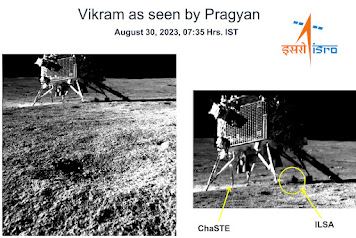At about 6.05 pm on 23rd August 2023 when an elated ISRO chairman S. Somanath proudly claimed in his speech addressing the Prime Minister of India, Sri. Narendra Modi, "Sir, India is on the Moon", history was already written just a minute before when the lander Vikram of Chandrayaan-3 had made a successful soft-landing on the surface of south pole of the Moon. Thus, India became only the fourth nation to achieve a soft-landing on moon after the USSR, the USA, and China, and with it the very first nation to reach the southern hemisphere of the only satellite of Earth.
India's journey towards moon began in the year 2008 with Chandrayaan-1 which was an 'Impact mission'. In that lunar venture India had to only launch an impact probe that would crash down upon the surface of the moon. It was also a successful mission. But most importantly, for the first time ever in the history of moon missions, the Indian probe found the traces of water in the Shackleton crater of lunar south pole. Later, the point of impact was named Jawahar Point.
Then it was the turn of Chandrayaan-2. It was a 'Lander mission'. It meant the mission included a landing module which would make a soft-landing on the moon surface. Every Indian eye was glued to the television screen even at the dead of night. But to the horror of all Indian hopes, the lander crashed down on the moon's rocky surface on 6th September 2019. Later, it was told by ISRO (Indian Space Research Organization) that the control room in Bengaluru had lost all communication when the lander was just about to touch down. As per ISRO reports some software glitch was responsible for the failure. But now the mission is called a half-successful one because the orbiting module is still working and circling round the moon.
With confidence surging and faith soaring high all the time, ISRO was never to give up on landing on the moon one day. So, it kept working. The engineers and scientists identified the issues with the previous mission and rectified them for the one coming up next, Chandrayaan-3 in 2023. Just like the previous mission, Chandrayaan-3 had a lander, Vikram, and a rover, Pragyan. After all the critical issues having been fixed Chandrayaan-3 had the lift-off in an LMV-3 rocket booster from the second launch-pad at Satish Dhawan Space Centre in Sriharikota at 2.35 pm on 14th July 2023.
About two moths later, when the lander Vikram was once again in its descent towards the lunar surface it became an international event with a record-breaking 8 million viewership on YouTube. This time round, there was no fear of failure whatsoever. The entire world watched with wonder that following the respective Hard-braking phase, Attitude-hold phase, Fine-braking phase and Local-navigation phase, the lander Vikram had achieved the objective of soft-landing on the moon. What then ensued was just the deafening roar of entry of India into the elite space club of the world's leading countries.






Comments
Post a Comment